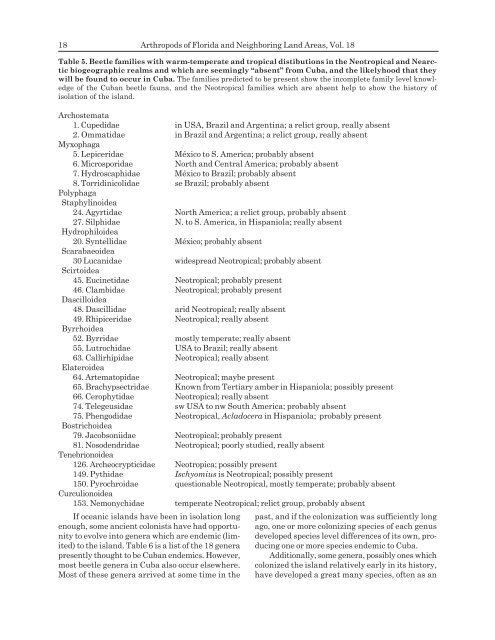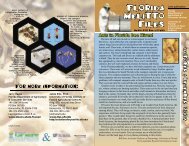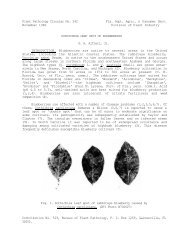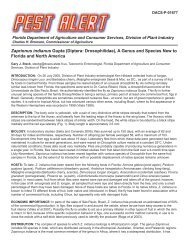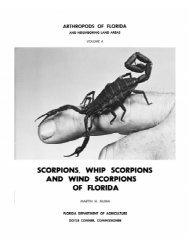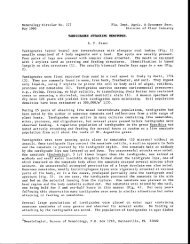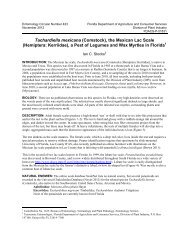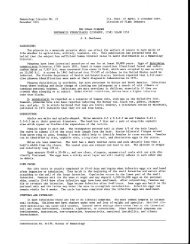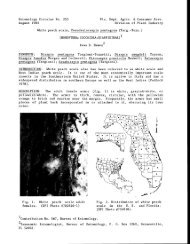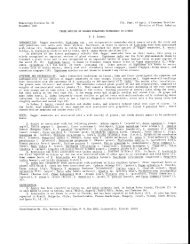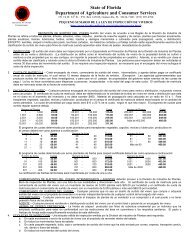A Checklist of the Beetles of Cuba with Data on Distributions and ...
A Checklist of the Beetles of Cuba with Data on Distributions and ...
A Checklist of the Beetles of Cuba with Data on Distributions and ...
Create successful ePaper yourself
Turn your PDF publications into a flip-book with our unique Google optimized e-Paper software.
18<br />
Arthropods <str<strong>on</strong>g>of</str<strong>on</strong>g> Florida <strong>and</strong> Neighboring L<strong>and</strong> Areas, Vol. 18<br />
Table 5. Beetle families <str<strong>on</strong>g>with</str<strong>on</strong>g> warm-temperate <strong>and</strong> tropical distibuti<strong>on</strong>s in <str<strong>on</strong>g>the</str<strong>on</strong>g> Neotropical <strong>and</strong> Nearctic<br />
biogeographic realms <strong>and</strong> which are seemingly “absent” from <str<strong>on</strong>g>Cuba</str<strong>on</strong>g>, <strong>and</strong> <str<strong>on</strong>g>the</str<strong>on</strong>g> likelyhood that <str<strong>on</strong>g>the</str<strong>on</strong>g>y<br />
will be found to occur in <str<strong>on</strong>g>Cuba</str<strong>on</strong>g>. The families predicted to be present show <str<strong>on</strong>g>the</str<strong>on</strong>g> incomplete family level knowledge<br />
<str<strong>on</strong>g>of</str<strong>on</strong>g> <str<strong>on</strong>g>the</str<strong>on</strong>g> <str<strong>on</strong>g>Cuba</str<strong>on</strong>g>n beetle fauna, <strong>and</strong> <str<strong>on</strong>g>the</str<strong>on</strong>g> Neotropical families which are absent help to show <str<strong>on</strong>g>the</str<strong>on</strong>g> history <str<strong>on</strong>g>of</str<strong>on</strong>g><br />
isolati<strong>on</strong> <str<strong>on</strong>g>of</str<strong>on</strong>g> <str<strong>on</strong>g>the</str<strong>on</strong>g> isl<strong>and</strong>.<br />
Archostemata<br />
1. Cupedidae in USA, Brazil <strong>and</strong> Argentina; a relict group, really absent<br />
2. Ommatidae in Brazil <strong>and</strong> Argentina; a relict group, really absent<br />
Myxophaga<br />
5. Lepiceridae México to S. America; probably absent<br />
6. Microsporidae North <strong>and</strong> Central America; probably absent<br />
7. Hydroscaphidae México to Brazil; probably absent<br />
8. Torridinicolidae se Brazil; probably absent<br />
Polyphaga<br />
Staphylinoidea<br />
24. Agyrtidae North America; a relict group, probably absent<br />
27. Silphidae N. to S. America, in Hispaniola; really absent<br />
Hydrophiloidea<br />
20. Syntellidae México; probably absent<br />
Scarabaeoidea<br />
30 Lucanidae widespread Neotropical; probably absent<br />
Scirtoidea<br />
45. Eucinetidae Neotropical; probably present<br />
46. Clambidae Neotropical; probably present<br />
Dascilloidea<br />
48. Dascillidae arid Neotropical; really absent<br />
49. Rhipiceridae Neotropical; really absent<br />
Byrrhoidea<br />
52. Byrridae mostly temperate; really absent<br />
55. Lutrochidae USA to Brazil; really absent<br />
63. Callirhipidae Neotropical; really absent<br />
Elateroidea<br />
64. Artematopidae Neotropical; maybe present<br />
65. Brachypsectridae Known from Tertiary amber in Hispaniola; possibly present<br />
66. Cerophytidae Neotropical; really absent<br />
74. Telegeusidae sw USA to nw South America; probably absent<br />
75. Phengodidae Neotropical, Acladocera in Hispaniola; probably present<br />
Bostrichoidea<br />
79. Jacobs<strong>on</strong>iidae Neotropical; probably present<br />
81. Nosodendridae Neotropical; poorly studied, really absent<br />
Tenebri<strong>on</strong>oidea<br />
126. Archeocrypticidae Neotropica; possibly present<br />
149. Pythidae Ischyomius is Neotropical; possibly present<br />
150. Pyrochroidae questi<strong>on</strong>able Neotropical, mostly temperate; probably absent<br />
Curculi<strong>on</strong>oidea<br />
153. Nem<strong>on</strong>ychidae temperate Neotropical; relict group, probably absent<br />
If oceanic isl<strong>and</strong>s have been in isolati<strong>on</strong> l<strong>on</strong>g<br />
enough, some ancient col<strong>on</strong>ists have had opportunity<br />
to evolve into genera which are endemic (limited)<br />
to <str<strong>on</strong>g>the</str<strong>on</strong>g> isl<strong>and</strong>. Table 6 is a list <str<strong>on</strong>g>of</str<strong>on</strong>g> <str<strong>on</strong>g>the</str<strong>on</strong>g> 18 genera<br />
presently thought to be <str<strong>on</strong>g>Cuba</str<strong>on</strong>g>n endemics. However,<br />
most beetle genera in <str<strong>on</strong>g>Cuba</str<strong>on</strong>g> also occur elsewhere.<br />
Most <str<strong>on</strong>g>of</str<strong>on</strong>g> <str<strong>on</strong>g>the</str<strong>on</strong>g>se genera arrived at some time in <str<strong>on</strong>g>the</str<strong>on</strong>g><br />
past, <strong>and</strong> if <str<strong>on</strong>g>the</str<strong>on</strong>g> col<strong>on</strong>izati<strong>on</strong> was sufficiently l<strong>on</strong>g<br />
ago, <strong>on</strong>e or more col<strong>on</strong>izing species <str<strong>on</strong>g>of</str<strong>on</strong>g> each genus<br />
developed species level differences <str<strong>on</strong>g>of</str<strong>on</strong>g> its own, producing<br />
<strong>on</strong>e or more species endemic to <str<strong>on</strong>g>Cuba</str<strong>on</strong>g>.<br />
Additi<strong>on</strong>ally, some genera, possibly <strong>on</strong>es which<br />
col<strong>on</strong>ized <str<strong>on</strong>g>the</str<strong>on</strong>g> isl<strong>and</strong> relatively early in its history,<br />
have developed a great many species, <str<strong>on</strong>g>of</str<strong>on</strong>g>ten as an


